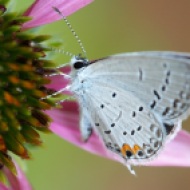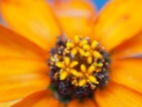There are lots of reasons to move up to an interchangeable lens system camera. I say “interchangeable lens system”, because technically I do not shoot a DSLR. DSLR stands for Digital Single Lens Reflex – meaning that you look through the lens you shoot with and that is made possible by reflection, a mirror that rests below the viewfinder. I shoot “mirrorless” – specifically micro 4/3. Because there is no mirror the space between the sensor and the lens can be dramatically reduced, allowing for smaller cameras and lenses. I can carry a three to four lens kit in a messenger bag with all the bells and whistles. The smaller distance means that the focal equivalents are not the same as standard DSLRs which operate on the 35mm camera equivalents. My focal lengths offer twice the reach – so a fast 50mm portrait lens is only a 25mm lens in my system. My 75-300mm bird lens is equivalent to a 150-600mm zoom on a DSLR. It makes for a compact and somewhat inconspicuous kit.
One of the things I love is shooting with a dedicated macro lens. I have been using a 45mm Leica macro lens for the last year or so. The 35mm equivalent would be twice that – 90mm. It’s a great lens but often can’t get me as close as I would like. I have a vintage macro bellows set up that is fun to use with the right subject, but lacks portability. Recently I acquired a new 60mm (120mm equivalent) 1:1 ratio lens and I am loving it. I haven’t had the time to take it out with the tripod to go crazy with the details, but I did get a chance to take it out for a spin around the formal gardens of Eureka Springs, Arkansas last week.
Click along and walk with me up Spring Street and enjoy the gardens.
Coneflowers – there is something about the coneflower that draws me back every year – the shape, the color, the insects – all of this and its perfectly spaced center structures make it lovely from almost any angle.
Orange Petals – I am drawn to oranges in nature in any season. The macro lens allows me to focus close and then focus closer. I tend to shoot flowers in aperture mode, playing with the DOF. New details emerge as the depth of field gets tighter and tighter. Light through petals reveals structure.
The Buzz – I love the challenge of capturing a bumble bee in action, and nothing is better than seeing the individual pollen grains. Shooting on a full-function camera lets you switch to shutter mode to try to freeze their constant motion.
Thistles – I know they are invasive weeds, but I love thistles. The thrive in places where nothing else does. A couple of years ago a springtime flood created a slide on one of the city’s mountainsides. To prevent future slides deep rooting grasses were planted and the hillside was slightly terraced. The following year the grass came up, but within it were thousands of thistles. They are on a spot where the late day sun isolates them against the sky. They make for a stunning horizon, but it’s their structure that draws me.
Nature’s Spirograph – on that same hillside I see daisies below the grass line. I love the geometry that you find when you get close to daisies and similar petalled flowers like brown-eyed susans. Often after shooting you find that there is more wildlife than you had bargained for in your frame.
Ready for their close-ups – as much as I love categories, not everything fits neatly into sets when I shoot. Sometimes something just catches my eye and I shoot one or two frames.
Not bad for a first outing. I made the choice to leave my camera bag in the car and shoot only with the new lens. I find that this is a great way to get to know a lens, to force yourself to depend on it for the shot. Personally, I love new gear, but often depend on the old favorites and it’s good to get out there and push yourself outside of your comfort zone.
If you are a photog, what lens do you have sitting around that you haven’t gotten to know as well as you should?































Beautiful, love the small details in these photos.
Thank you – That’s the best thing about macro shooting, seeing what you miss.
Love the orange pics
that colour always brightens the day
Mine too – I’m drawn to orange.
So very beautiful. It was dark and rainy here today; thanks for the bit of sunshine!
Since my OMD arrived, my DSLR and 70-200mm hardly gets used outside of client work. If I could find an adapter of the OMD to use the 70-200mm then…….
Nice photos btw 🙂
Thanks – the OMD is the mirrorless camera I have been waiting for – it’s not a novelty like the early Pens. I have a few adapters – fairly easy to find online. I have an OM and a 4/3 that I bought from either Olympus or Lumix. I’m pretty happy with the Oly 75-300 so far.
You have peaked my interest in your DSLR system. I have been under the impression that all DSLRs were converted 35mm systems. What model camera/lens system are you using?
Your photos in this post are outstanding.
Thanks Allan.
There are several mirrorless systems – Sony, Nikon, and even Canon all have one now too. The first practical one was the micro 4/3 system I use.
I shoot an Olympus OMD (or E-M5). I bought into the Pen line when it was introduced about 4 years ago because it was compact and because it would be easy to use my old manual Olympus OM lenses from the 70s and 80s. I had been using an Oly super zoom and loved Olympus color (I made no color or saturation edits on any of these images).
I work on a D90 Nikon at work and just didn’t want a kit that large to carry. The OMD is smaller than my rangefinder from the 70s and is as full-functioned as any Nikon or Canon. Another plus is that Panasonic (who bought Leica) also uses the same mount for it’s Lumix line – so the Lumix Cameras can share lenses – meaning that although it’s a newer system there are lots of lens options. Olympus was always known for making smart small cameras with exquisite glass and I think that is still their reputation today. OK – I’m a fan 🙂 The early pens were pretty spartan, no EVF and slower AF – but the newer models are very competitive with full size DSLRs in performance.
Thank you for the information, Lorri. I have no desire to carry lots of bulky eqpt. and your system style has a certain appeal. I will do some research on it for sure.
Have you ever heard of Borrow Lenses? I have rented equipment from them to see if I liked it first. It’s pretty reasonable and makes it easier to know if equipment is a fit.
I have heard of a .com that rents lenses and also has stores in major cities. Would that be this business?
Yes, there may be others – borrrowlenses.com has offices in major cities and pretty fair rates.
Lovely images!
Thanks so much!
Love the shots, Lorri. I particularly like the Echinacea (or coneflower as you call it).
My ‘nifty 50’ still doesn’t seem to get much use, so I bought a new(er) body at a sale about 3 -4 weeks ago. The idea being to leave the 50mm on one of the bodies all the time and carry two cameras with the two main lenses. Then I got sick and didn’t do anything much for about 2 weeks, so just waiting for a chance to use that 50mm more when the weather’s better.
(The interesting thing is that the new body Canon EOS 600D was nearly $300 less than the old 2009 version of the Canon EOS 500D which I bought 2 1/2 yrs ago).
600D is 18 mp (whereas the old 500D was 15 mp) – it’s amazing the difference with the extra 3 mp.
Thanks Vicki – we call it echinacea here too, but I misspell it so often I use the colloquial:) I think a second body is a great idea. I kept my last body and use it for my tilt-shift set up. It’s also great to have around when I want to take someone out for a photo day who doesn’t have a kit.
I’ve noticed that prices have dropped pretty significantly unless you are looking at the top end models in a brand. You are so right about megapixels – my newest body is 18mp – a huge jump from my old one at 12mp – a big jump in sharpness!
Great shots! I read with awe.. the technical side of photography is way over my phone-camera head 8) would you consider writing a post for amateurs about how to better our composition skills? I’m a center-the-subject kinda girl. Thanks!
Thanks – I have been thinking about writing a post about composition for a while now – maybe I can put something together. I think it’s pretty common to center objects, most cameras focus on the center point by default.
Once again. Amazing…
The colors speak for themself…
Thank you Bjorn!
Wow! Informative and such stunning shots, thank you for the journey through Eureka Springs. I learned a lot from this post.
Thanks for visiting! Eureka is a photogs dream, I’m lucky to live so close.
This may be one of your best posts…informative, and the photo quality is wonderful. Cheers!
Thanks so much – it was a fun set to sort through.
Love macro shots, my absolute favorite–and “The bee’s knees” in that first set is divine!
Thanks Mrs. Fringe – macro is one of my favorite things. Bees are just so amazing to look at so close.
They really are. Almost as cool as corals 😉
I would like to shoot some corals 😊
It’s amazing, truly! Get thee to your closest aquarium 🙂
🙂
Green with envy here!
Fabulous shots!
Thank you!